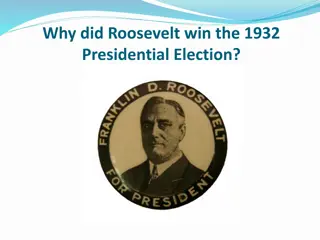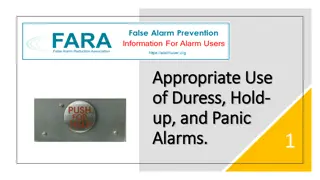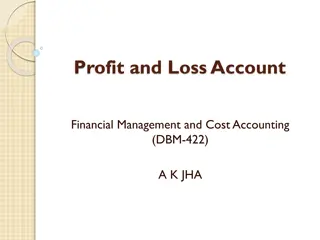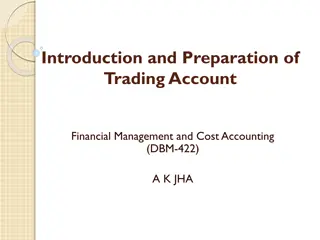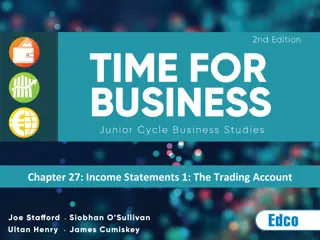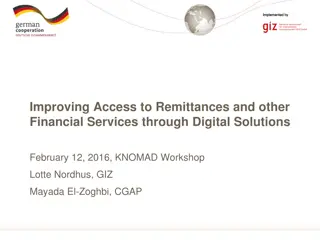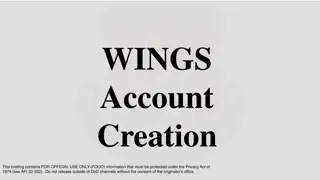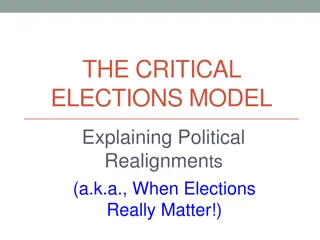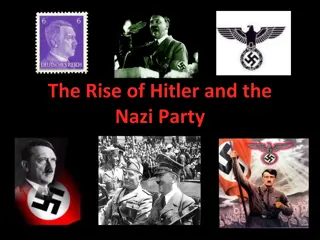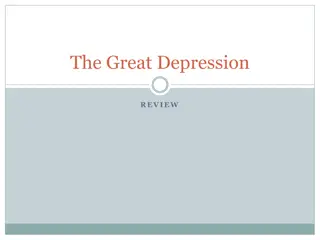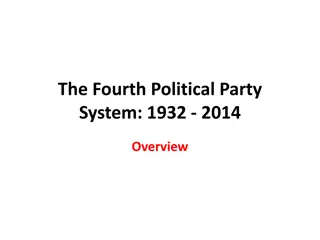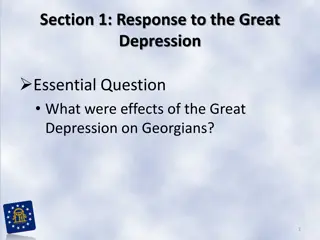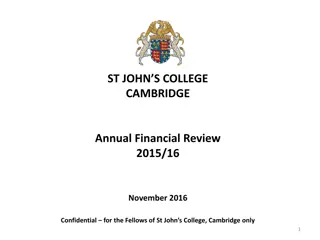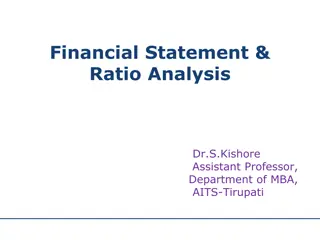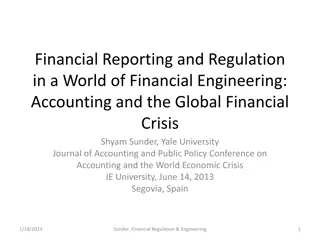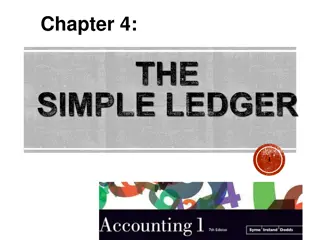The Financial Panic of 1932-33: A Historical Account
The Financial Panic of 1932-33 was marked by a stock market bubble, bank runs, and an international crisis. The Great Bubble of the 1920s led to severe economic repercussions, with banks facing liquidity problems and a lack of support from the Federal Reserve. Bankers' responses and the economic indicators of the time reflect a challenging period in American history.
Download Presentation

Please find below an Image/Link to download the presentation.
The content on the website is provided AS IS for your information and personal use only. It may not be sold, licensed, or shared on other websites without obtaining consent from the author. Download presentation by click this link. If you encounter any issues during the download, it is possible that the publisher has removed the file from their server.
E N D
Presentation Transcript
Topic 3. Part 2. The Financial Panic of 1932-33
A Stock Market Bubble in the USA, Bank Runs, and an International Crisis
The Great Bubble: Suppose You had $100 to invest in the Stock Market in July 1926 July 1926 $100 July 1927 112 July 1928 148 January 1929 193 September 1929 216 December 1929 147 December 1930 102 July 1932 34
Kennedy (p. 20) Bankers' Response to the Economic Slide from late 1929 - 1931: 1) Depositors withdrew funds for living expenses and/or fear of bank failures; 2) Banks faced Liquidity Problems as their holdings in securities fell in value so they sold at the low prices to get cash; 3) Federal Reserve policy did not include supporting the prices on government securities to counter the depressed bond market.
Kennedy (p. 20-21) By protecting themselves rather than by helping others fight the depression, bankers abdicated leadership in their communities and threw away prestige with both hands. The same men who had claimed credit for prosperity refused to accept responsibility for adversity and rejected the opportunity to maintain confidence in themselves and their institutions.
Kennedy (p. 21) "Throughout the 1920s and until 1931, the nation had looked to its bankers first to ensure prosperity and then to lead others out of the depression; thereafter, however, the bankers seemed scarcely able to help themselves. Loss of confidence in the leaders of finance, moreover, made the depression harder to fight and increased the burden on those left in command.
ECONOMICS Unemployment GNP Consumer Prices Manufacturing Investment Stocks 1929 3.2 104.4a 73.3b 58b 16.2c 260.2d 1930 8.7 95.1 71.4 48 10.3 210.3 1931 15.9 89.5 65.0 39 5.5 136.6 1932 23.6 76.4 58.4 30 .9 69.3 1933 24.9 74.2 55.3 36 1.4 89.6 1934 21.7 80.8 57.2 39 2.9 98.4 1935 20.1 91.4 58.7 46 6.3 106.0 1936 16.9 100.9 59.3 55 8.4 154.7 1937 14.3 109.1 61.4 60 11.9 154.1 1938 19.0 103.2 60.3 46 6.7 114.9 1939 17.2 111.0 59.4 57 9.3 120.6 1940 14.6 121.0 59.9 66 13.2 110.2 1941 9.9 138.7 62.9 88 18.1 98.2 a $ Billions in 1929 Prices. b 1947-49 = 100 base c Gross Private Domestic Investment ($ Billions) d Average Prices of Stocks (1941-43 = 100)
Hoover's Responses to the Crisis Was to Try to increase Confidence November 1929 -- Meets with Leaders of industry, agriculture, and labor in an effort to maintain wage rates. December 1929 -- Urges Congress to do a Study of the Structure of Banking and its Problems (but no follow up) Late 1929 and throughout 1930 -- Hoover constantly predicted an imminent end to depression but hard times persisted dissipating Americans' confidence in Hoover's leadership
1931 Failure of the Central European Banks By the Spring of 1931 Conditions in the USA had Stabilized somewhat and there was hope that the crisis might begin to abate. In Europe, prices began to slide and the European Central Banks in Austria and Germany began to have problems. In June Hoover proposed a one year moratorium on World War I debts and reparations. Whatever unity there was on monetary policy collapsed and the British Government went off the Gold Standard on 21 September 1931.
After the British went off the Gold Standard it was every country for itself. Gold flowed out of the USA. Bank Runs accelerated and 1,860 closed between August 1931 and January 1932. p.53 Hoover believed that banking and business could revive without fundamental changes in they merely received temporary supports from agencies such as the RFC [Reconstruction Finance Corporation] or through the Federal Reserve banks. Thus the president held to a sustaining action, hoping to tide over the banks until they could work out their own survival.
Susan Estabrook Kennedy's Main Conclusions on Hoovers Actions 1) Hoover was the wrong man in the wrong place at the wrong time. He was temperamentally unsuited for a crisis Presidency. He kept saying things were fine because he felt it was a crisis of confidence. This fatally undermined his credibility. 2) He was trapped along with the Bankers in a mindset that demanded collateral for every loan. Unlike J. P. Morgan's actions in 1907, he and the Banks could not (and would not) coordinate actions to stop bank runs. A good example is Detroit where Hoover pleaded with Henry and Edsel Ford to help prop up the Detroit banks. Another example is Nevada.
3) During the long period between the 1932 election in November and Roosevelt taking office in March, Hoover became fixated on trying to get FDR to help him with the crisis. This only made things worse as all across the country banks were failing by the thousands. 4) During February and March of 1933 the Senate Banking and Currency Committee heard Ferdinand Pecora (who started his investigation in 1932) expose massive losses by the National City Bank of New York on its investments (that is, it mixed deposit with investment banking). This destroyed whatever prestige the Bankers had left.
Ferdinand Pecora Chief Counsel to the U.S. Senate Committee on Banking and Currency 6 January 1882 7 December 1971
The Nation: "If you steal $25, you're a thief. If you steal $250,000 you're an embezzler. If you steal $2,500,000 you are a financier. 5) Near the end of his Presidency in February and March of 1933 Hoover became so delusional that he blamed Roosevelt for creating uncertainty! 6) By Hoover s last day in office, 3 March 1933, the crisis was extremely serious. By early March 5,504 banks had closed their doors. New York and Chicago faced acute gold losses and the Federal Reserve Banks were running out of resources to prop up the banks in many states.
President Franklin Delano Roosevelt 4 March 1933 12 April 1945 30 January 1882 12 April 1945
Why Washington Delays in Solving Financial Crises Legislative Responses are delayed because of the institutional complexity. A Response usually occurs at Partisan transition (ideology -- 1933). Then the Response is often reversed after another Partisan transition (ideology This did not happen until 1999 so it does not quite fit the pattern).
The Banking Act of 1933 (GlassSteagall) Main Provisions: 1) Established the Federal Deposit Insurance Corporation (FDIC). It initially phased the system in and the insurance now stands at $250,000. 2) Required all FDIC insured banks to be, or to apply to become, members of the Federal Reserve System by 1 July 1934. The Banking Act of 1935 extended that deadline to 1 July 1936. State banks were not eligible to be members of the Federal Reserve System until they became stockholders of the FDIC, and thereby became an insured institution. Later legislation in 1939 removed this provision.
3) Separated Commercial and Investment Banking (the Banking Act of 1935 later clarified and cleaned up some of the language). Federal Reserve member banks could not: a) deal in non-governmental securities for customers b) invest in non-investment grade securities for themselves c) underwrite or distribute non-governmental securities d) share employees with companies involved in such activities e) securities firms and investment banks could not take deposits.
ECONOMICS Unemployment GNP Consumer Prices Manufacturing Investment Stocks 1929 3.2 104.4a 73.3b 58b 16.2c 260.2d 1930 8.7 95.1 71.4 48 10.3 210.3 1931 15.9 89.5 65.0 39 5.5 136.6 1932 23.6 76.4 58.4 30 .9 69.3 1933 24.9 74.2 55.3 36 1.4 89.6 1934 21.7 80.8 57.2 39 2.9 98.4 1935 20.1 91.4 58.7 46 6.3 106.0 1936 16.9 100.9 59.3 55 8.4 154.7 1937 14.3 109.1 61.4 60 11.9 154.1 1938 19.0 103.2 60.3 46 6.7 114.9 1939 17.2 111.0 59.4 57 9.3 120.6 1940 14.6 121.0 59.9 66 13.2 110.2 1941 9.9 138.7 62.9 88 18.1 98.2 a $ Billions in 1929 Prices. b 1947-49 = 100 base c Gross Private Domestic Investment ($ Billions) d Average Prices of Stocks (1941-43 = 100)
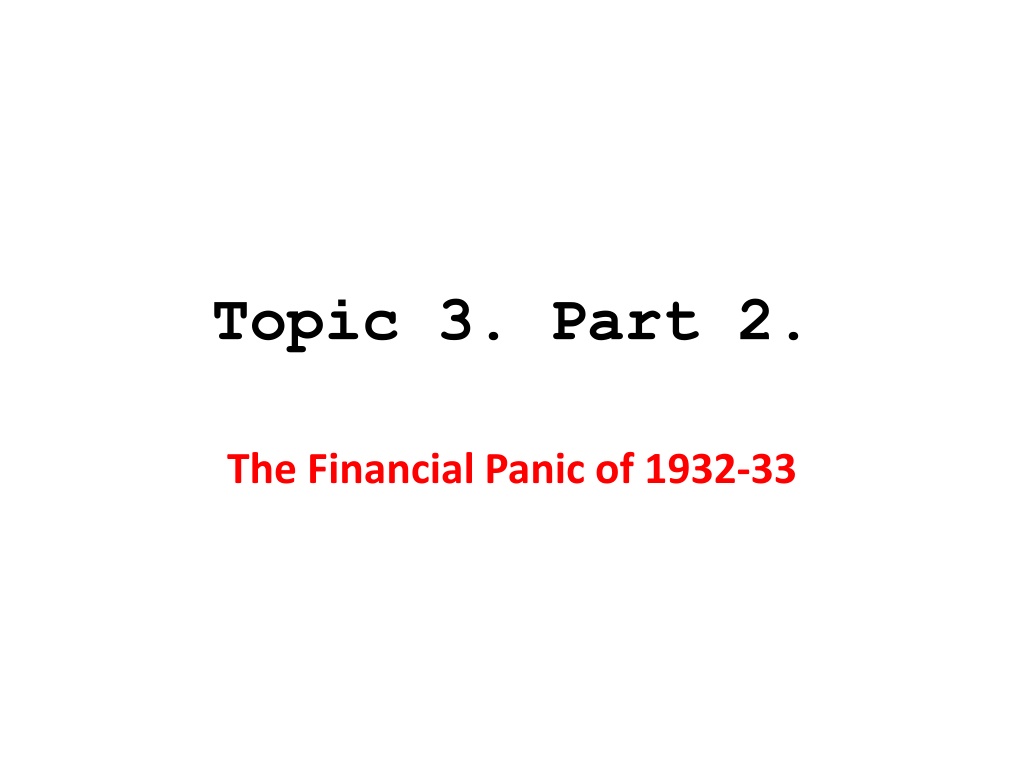

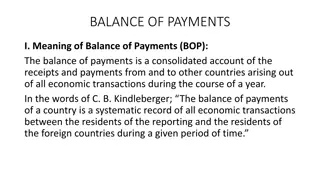


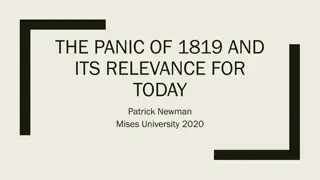

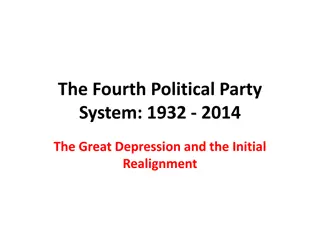
![Understanding Negligence Liability in Donoghue v. Stevenson [1932]](/thumb/198881/understanding-negligence-liability-in-donoghue-v-stevenson-1932.jpg)

